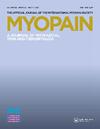Biomechanical Evaluation of Refractory Chronic Low Back Pain Treatment with Botulinum Toxin Type A
引用次数: 0
Abstract
Abstract Objectives: To investigate changes in isometric strength and the cross-sectional area [CSA] of the lumbar extensors induced by botulinum toxin type A [BoNT-A] treatment and the relationship between these changes and the clinical efficacy of BoNT-A for reducing refractory chronic low back pain [LBP]. Methods: Thirty-five patients suffered from chronic LBP refractory to other conservative treatments. Each was injected with 50 units of BoNT-A [Dysport®, Llandudno, UK] at the tender points in the lumbar extensor muscles. Visual analog scale [VAS] pain scores, Oswestry Low Back Pain Questionnaire [OLBPQ] responses, changes in the isometric strength, and CSA of the lumbar extensors were assessed at baseline and 1, 2, and 3 months. Results: The VAS pain scores were significantly reduced at all post-treatment time points. A significant improvement in mean OLBPQ scores was evident at 2 and 3 months after treatment. Significant increases in lumbar extensor isometric strength were observed at three months on 0°, 24°, and 60° lumbar flexion angles. Increases in muscle size were seen at the L3-4 inter-vertebral level and the L4-5 inter-vertebral level at 3 months. No strong correlation was found between VAS score and isometric strength of the total lumbar extensor. The change in VAS scores was significantly correlated with the CSA of the L4-5 intervertebral level of extensor. A negative correlation was found between OLBPQ scores and isometric strength of the lumbar extensors. No serious adverse events were reported. Conclusion: The BoNT-A may have clinical utility in terms of pain reduction and functional improvement in patients with refractory chronic LBP. This therapy could serve as a suitable alternative for patients with refractory chronic LBP who experience no benefit from conservative treatments.A型肉毒毒素治疗难治性慢性腰痛的生物力学评价
摘要目的:探讨A型肉毒毒素[BoNT-A]治疗对腰伸肌等长强度和横截面积[CSA]的影响,以及这些变化与BoNT-A治疗难治性慢性腰痛[LBP]临床疗效的关系。方法:35例经其他保守治疗难治性慢性腰痛患者。每个患者在腰伸肌的压痛点注射50单位BoNT-A [Dysport®,Llandudno, UK]。在基线和1、2、3个月时评估视觉模拟量表(VAS)疼痛评分、Oswestry腰痛问卷(OLBPQ)反应、腰伸肌的等长强度变化和CSA。结果:治疗后各时间点VAS疼痛评分均显著降低。治疗后2个月和3个月,平均OLBPQ评分明显改善。3个月时,在0°、24°和60°腰椎屈曲角度时,腰伸肌等距强度显著增加。3个月时,L3-4椎间水平和L4-5椎间水平的肌肉大小增加。VAS评分与全腰伸肌等长肌力之间无明显相关性。VAS评分的变化与L4-5椎间伸肌水平的CSA有显著相关。OLBPQ评分与腰伸肌等长肌力呈负相关。无严重不良事件报告。结论:BoNT-A在缓解难治性慢性腰痛患者疼痛和改善功能方面可能具有临床应用价值。这种疗法可以作为难治性慢性腰痛患者的合适替代方案,这些患者在保守治疗中没有获益。
本文章由计算机程序翻译,如有差异,请以英文原文为准。
求助全文
约1分钟内获得全文
求助全文

 求助内容:
求助内容: 应助结果提醒方式:
应助结果提醒方式:


